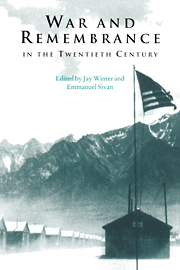Book contents
- Frontmatter
- Contents
- Preface
- Introduction
- 1 Setting the framework
- 2 Forms of kinship and remembrance in the aftermath of the Great War
- 3 War, death, and remembrance in Soviet Russia
- 4 Agents of memory: Spanish Civil War veterans and disabled soldiers
- 5 Children as war victims in postwar European cinema
- 6 From survivor to witness: voices from the Shoah
- 7 Landscapes of loss and remembrance: the case of Little Tokyo in Los Angeles
- 8 The Algerian War in French collective memory
- 9 Private pain and public remembrance in Israel
- 10 Personal narratives and commemoration
- 11 Against consolation: Walter Benjamin and the refusal to mourn
- Index
- Studies in the Social and Cultural History of Modern Warfare
10 - Personal narratives and commemoration
Published online by Cambridge University Press: 27 October 2009
- Frontmatter
- Contents
- Preface
- Introduction
- 1 Setting the framework
- 2 Forms of kinship and remembrance in the aftermath of the Great War
- 3 War, death, and remembrance in Soviet Russia
- 4 Agents of memory: Spanish Civil War veterans and disabled soldiers
- 5 Children as war victims in postwar European cinema
- 6 From survivor to witness: voices from the Shoah
- 7 Landscapes of loss and remembrance: the case of Little Tokyo in Los Angeles
- 8 The Algerian War in French collective memory
- 9 Private pain and public remembrance in Israel
- 10 Personal narratives and commemoration
- 11 Against consolation: Walter Benjamin and the refusal to mourn
- Index
- Studies in the Social and Cultural History of Modern Warfare
Summary
Writing about memories is less a way of finding out what actually occurred than what, in the fullness of time, one is capable of making of what may have done so.
Frank KermodeA personal narrative is what can be made of what may have happened; a personal narrative of war, then, is what can be made of remembered war. Men who write such narratives are makers, like poets (who are etymologically makers), and novelists, and all other constructers of words. But what exactly do they make? Are such narratives memorial gestures that fix and communicate public meaning, like war-monuments – the Cenotaph or the Marine Corps Memorial or the Menin Gate? Or are they a different kind of gesture, a different act of making?
If we follow James Young, and take memorial to be the general term for a class of collective gestures of public commemoration, including material objects (monuments), fixed days (Memorial Day), assigned spaces (Valley Forge Cemetery), and even unique occasions (meetings, conferences), then we must surely say that the written recollections of the men who performed the acts that taken together constitute a war must also be memorials.
But there are problems in the terms of that definition. In what sense are personal narratives collective? Are they generated by some common impulse beyond the personal? Are they conditioned by states of mind outside themselves? Do they individually belong to the art of public memory? Of national memory? Or are they a set of essentially private transactions between a man who was there and the things that happened where he was?
- Type
- Chapter
- Information
- War and Remembrance in the Twentieth Century , pp. 205 - 220Publisher: Cambridge University PressPrint publication year: 1999
- 17
- Cited by



